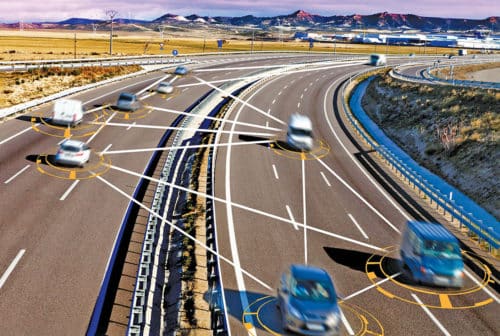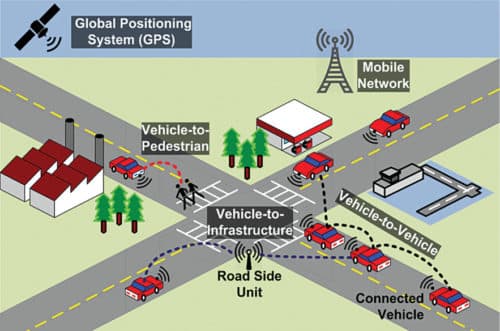The future of the automotive industry lies in connecting vehicles with almost every physical thing in its surrounding and to the cloud.
Wireless technologies are revolutionising connectivity in the modern automobile. Ensuring that these technologies operate as expected has become increasingly important.
To give the vehicles a more complete view of the world around, technologies like camera, radar and radio frequency (RF) communication work together with sensor fusion. New vehicles are integrating technologies that help provide advanced driver assistance system (ADAS) functionality, which will eventually lead to fully autonomous operations.
Evolution of wireless technology in automotives
Wireless technologies for automotives advanced with wireless locking and unlocking of doors using infrared (IR). Later, the industry adapted secure and encrypted RF technology for automatic garage door opening and closing with the door lock/unlock mechanism of the automobile.
Then came Bluetooth technology, which increased the convenience and comfort of the users. They could switch on/off appliances, like heaters and air-conditioners, wirelessly. Later, it became a key feature for infotainment systems, apart from providing vehicle diagnostics to the users through connected apps.
Use of Bluetooth technology has improved the overall safety of car users. Wireless connections relay high-quality audio, so that passengers can listen to their favourite music (stored on portable devices) and/or hook up their phones to the car.
Wi-Fi provides a robust data pipe for screen projection technologies. It enables seamless transition for the drivers, from their smartphones to cars of their own or rented from anywhere in the world.

Wireless technology applications for connected vehicles
Jeff Phillips, head – automotive marketing, National Instrument, says, “Vehicle-to-everything (V2X) communications require a framework to address the rapidly expanding compliance and certification requirements related to connectivity protocols and sensor control algorithms.
“V2X communications encompass both vehicle-to-vehicle (V2V) and vehicle-to-infrastructure (V2I). We have been working with radar, camera and RF communications for different industries, and natively support all input/output (I/O) types that need to be tested in today’s and tomorrow’s vehicles.”
Srinivasan Subramani, senior technical architect, Mistral Solutions, says, “As design service providers, we provide systems-on-module (SoM) solutions based on Qualcomm 820 and IMX systems-on-chip (SoC), for building infotainment systems. We are also working on 77GHz radars for collision warning, blind-spot detection and reverse assist applications in trucks and cars.
“We follow protocols and standards for design like CAN, LoRA, Bluetooth and Wi-Fi. Our embedded hardware and software solutions integrate audio, video, wireless technologies and DSP algorithms, paving the way for intelligent, connected infotainment devices.”
V2V communication
Vehicles on the road signal their intentions to others and warn them of hazards ahead through V2V communication. Information regarding road conditions and more can be used to manage and control traffic.
For example, if a car breaks suddenly to avoid an obstacle, it can send out wireless messages to nearby vehicles to inform them about the situation. Those vehicles can then slow down or change lanes accordingly. V2V offers a higher scale of safety for passengers. It is a form of IEEE 802.11 Wi-Fi protocol, re-engineered for much lower latency and better reliability.
Wireless Access in Vehicular Environments (WAVE), IEEE 802.11p, operates near 5.9GHz frequency and supports data rates up to 27Mbps. To extend the range of the warnings, messages picked up by passing vehicles can be relayed over WAVE using V2V communications. Roadside beacons using Bluetooth can pass on information about local points of interest. This information comes in handy for people looking for such details on the Internet using the vehicle’s built-in Wi-Fi.
V2I communication
V2I communication provides information to roadside controllers for updating vehicles on their status. Traffic signals send information to vehicles to tell them when they are likely to change state. Vehicles passing the junction relay that information to approaching cars. The overall effect is less wear and tear on brakes and savings in terms of fuel.
In the future, wireless signals could improve the flow of autonomous vehicles considerably. Traffic signals could monitor the junction to check for safe conditions and regulate traffic.
V2I allows communication with many safety applications, digital sign boards, transfer location information and cellular long-range communication, to share information regarding traffic conditions and reduce congestion.
Rajiv Baby, application engineer, Qualcomm, says, “Our Snapdragon 602A processors and modems provide superior wireless solutions. The processors are engineered to support today’s technology, while adapting to future wireless releases. These offer media streaming, parking assistance, 3D navigation, as well as voice, facial and device recognition.
“Automobiles can integrate additional wireless technologies like Bluetooth, Wi-Fi and Global Navigation Satellite System (GNSS) with advanced 3G/4G LTE technology.
“To simply park over a designated ground-based charging pad and get charged, Qualcomm Halo WEVC is an energy-charging solution. Qualcomm 9150 C-V2X chipset is a cellular V2X solution based on 3rd Generation Partnership Project (3GPP) release 14 specifications.
Snapdragon and Atlas 7 processors provide satellite-based, geo-location mapping information and support for BREW Development System, GPS, GLONASS and Galileo.”

Efficient road navigation using digital data
Wireless technology for automobiles includes RF environments that use Wi-Fi with WAVE, Bluetooth and GPS. Wireless communication allows drivers to locate precisely and transmit information with low latency for efficient navigation.
Modern navigation techniques allow them to easily navigate using GPS/GLONASS systems. These systems detect the presence of people and alert drivers, pedestrians, bicyclists and motorcyclists through smartphone applications. Alerts for emergency situations can be activated during accidents. This speeds up rescue operations, clearing and recovery of motorways.
Theft alert is an added security option for modern connecting vehicles. Vehicle-to-cloud (V2C) communication provides security authentications and information about parking lots.
The Internet of Things (IoT) with smart sensor technology offers effective management of inventory along with service and repair schedules of connecting vehicles. Sensors designed for specific applications detect the condition of a spare and send an alert to the service provider, who can then schedule for maintenance.

Today’s wireless technologies are safe, secure, efficienct and convenient. We can connect our smartphones and other smart devices to automobiles using Wi-Fi, Bluetooth and the like. We can pair our devices with infotainment systems, which respond to voice commands and handle hands-free mode to answer calls while driving.
Modern communication networks like LTE and LTE-Advanced enable smart cars to communicate with each other. The IoT and 5G network offer effective management of smart driving. The future of the automotive industry lies in connecting vehicles with almost every physical thing in its surrounding and to the cloud.







NIce blog,thanks for sharing this article…